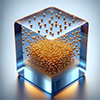| Dec 27, 2023 |
|
(Nanowerk News) Artisans have long marveled at vivid red colors produced by gold nanoparticles scattered within stained glass masterpieces. But the quantum origins of such optical wonder remained shrouded in mystery until modern advances in nanoengineering and microscopy illuminated intricacies of plasmon resonance. Now researchers stand poised to propel nanoplasmonic technologies previously harnessed for art into emerging photonic, sensing and amplification applications.
|
|
Research into these unique plasmonic properties slowed due to enduring challenges fabricating metal nanoparticles with precise control over size, concentration and dispersion within the glass itself. Early fabrication techniques proved unreliable when applied to tellurite glass, which otherwise boasts qualities ideal for integrated nanophotonic devices.
|
|
Yet progress stalled due to challenges fabricating metal nanoparticles with precise control within promising host media like tellurite glass. While boasting exceptional qualities for integrated optics, reliably incorporating tailored metal nanostructures to tap plasmonic potential had proven an enduring challenge for tellurite researchers.
|
|
Tellurite glass has emerged as an exceptionally promising host medium for integrated photonic devices. It boasts unique attributes including wide infrared transparency spanning half the solar spectrum, high solubility enabling intense rare earth luminescence, and relatively low processing temperatures. The moderate phonon energies characteristic of tellurite glass minimally interferes with radiative transitions, enabling efficient light emission and amplification. Additionally, tellurite glass demonstrates remarkable stability against crystallization.
|
|
These combined qualities make tellurite glass an ideal platform for developing active and passive photonic components, from amplifiers and color converters to planar waveguides and lasers. Specifically, its optical merits provide the capacity to both guide light and harness rare earth elements’ luminous transitions within a common material system.
|
|
However, realizing many of tellurite’s compelling applications depends profoundly on introducing and controlling nanoscale metallic features to manipulate light propagation via plasmonics. Despite immense interest, reliably incorporating tailored metal nanostructures like gold nanoparticles to activate plasmonic effects in tellurite glass remained an enduring technical barrier that stalled progress.
|
|
By developing techniques to systematically engineer gold nanoparticles offering tunable plasmonic response inside tellurite glass, the latest research by an Australian-German collaboration now paves the way to harness and explore plasmon-enhanced optical effects in this exceptional host medium. Unlocking control over these nanoscale plasmonic entities cracks open possibilities for advancing photonic devices incorporating tellurite materials.
|
|
These materials scientists developed novel techniques to systematically fabricate gold nanoparticles offering tunable plasmonic resonance bands in tellurite glass matrices. Their research provides a roadmap for deliberately engineering nanoparticle traits to further photonics and sensing research.
|
|
In a study published in Light: Science and Applications (“Controlled formation of gold nanoparticles with tunable plasmonic properties in tellurite glass”), the researchers combined controlled corrosion of a gold crucible during glass melting with a specialized reheating of dried glass powder. The reliable two-step process enabled precise control over the size, concentration and dispersion of gold nanoparticles formed within the tellurite glass.
|
|
The team first showed existing methods that worked for silicate glasses struggled when applied to tellurite. Doping the raw glass mixture with gold salt before melting led to unpredictable nanoparticle formation. The researchers demonstrated dramatically higher and consistent doping levels by intentionally corroding a gold crucible containing the molten glass. Oxidation reactions along the melt-crucible interface continuously introduced gold ions into the mix.
|
|
But simply dissolving gold ions into the tellurite glass melt did not automatically yield nanoparticles with consistent plasmonic signatures. The researchers discovered that grinding the solidified glass into a fine powder, then carefully reheating it, reliably triggered the gold ion reduction reactions necessary to nucleate gold nanoparticles. Reheating the bulk glass failed to produce this effect.
|
|
By tuning the glass melt temperature and duration within the gold crucible, the scientists controlled the gold ion concentration from 6 parts per million up to 75 ppm. Adjusting the powder reheating temperature and time reliably formed gold nanoparticles ranging from 30 to 90 nanometers, with number densities tunable over two orders of magnitude.
|
|
The ability to systematically vary nanoparticle size, concentration and dispersion enables deliberate engineering of plasmon resonance features. This unlocks opportunities to thoroughly investigate enhancing rare earth luminescence through coupling with tailored plasmonic gold nanoparticles distributed within the tellurite glass volume.
|
|
By solving the enduring challenges around reliably fabricating gold nanoparticles offering tunable plasmonic response, the researchers pushed wide open the door to exploring plasmonics effects in tellurite glasses. Their techniques overcome prior barriers that hindered such investigations by enabling deliberate control over nanoparticle characteristics like size and spacing.
|
|
The outcomes could impact future tellurite-based amplifiers, lasers, polarizers and sensors. But more fundamentally, systematically fabricating designer nanoparticles may further reveal intricate details of light-matter interactions governed by plasmon resonance – illuminating quantum effects spanning the transition between the microscopic particle and macroscopic optical wave regimes.
|

